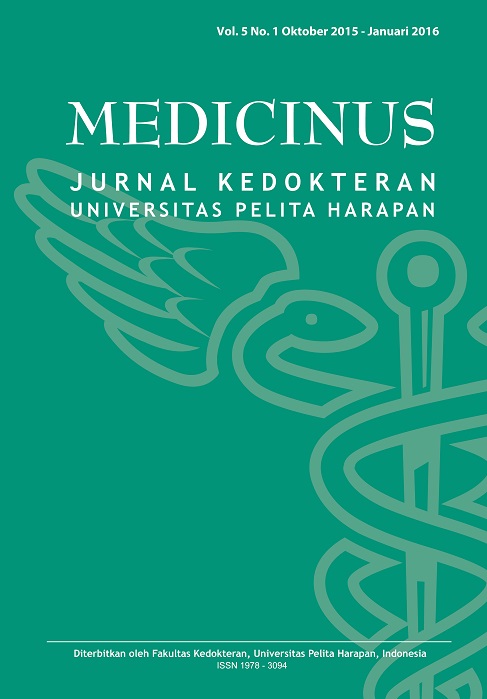Comparing The Who 1997 / Who Searo 2011 And Who 2009 Dengue Classification In Diagnosing Dengue Infection In Out-Patient Settings In Tangerang District, Banten Province, Indonesia
DOI:
https://doi.org/10.19166/med.v5i1.1180Abstract
The World Health Organization (WHO) 1997 / WHO (Regional Office of South-East Asia) SEARO 2011 and WHO 2009 dengue guideline emphasized different aspects. Indonesia as a limited resources hyperendemic area will a large number of patients hopitalized using the WHO 2009. This study compared the adult non severe dengue cases in out-patient settings using both classification. This retrospective cohort study on 85 patients found 48 dengue cases confirmed by reverse transcriptase polymerase chain reaction (RT-PCR) on the period of August 2011 - January 2012, in 5 out-patient settings health facilities. The sensitivity and spesificity of WHO 1997 / WHO SEARO 2011 were 48.93% and 23.68%, while the WHO 2009 were 78.72% and 68.42%. Out of 8 secondary infection patients, 25% in WHO 1997 / WHO SEARO 2011 and 0% in WHO 2009 were classified as the more severe form. The WHO 2009 shown higher sensitivity and specificity, but the WHO 1997 / WHO SEARO 2011 could diagnose more patient that would have suffered severe forms of dengue and also more secondary infection who have the probability of severe forms compared to WHO 2009.
Keywords: dengue, out-patient setting, world health organization
References
World Health Organization, Regional Office for South East Asia (2011) Comprehensive Guidelines for Prevention and Control of Dengue and Dengue Haemorrhagic Fever: Revised and expanded edition. New Delhi, India: World Health Organization. p.
World Health Organization (1997) Dengue haemorrhagic fever: diagnosis, treatment, prevention and control. 2nd edition. Geneva. p.
Seet RCS, Ooi EE, Wong HB, Paton NI (2005) An outbreak of primary dengue infection among migrant Chinese workers in Singapore characterized by prominent gastrointestinal symptoms and a high proportion of symptomatic cases. J Clin Virol 33: 336-340. doi:10.1016/j.jcv.2005.03.002.
Garcı´a-Rivera EJ, Rigau-Pe´rez JG (2002) Encephalitis and dengue. Lancet 360:261. doi:10.1016/S0140-6736(02)09481-3.
World Health Organization (2009) Dengue: guidelines for diagnosis, treatment, prevention and control. New ed. Geneva: World Health Organization. p.
Barniol J, Gaczkowski R, Barbato EV, da Cunha RV, Salgado D, Martinez E, et al (2011) Usefulness and applicability of the revised dengue case classification by disease: multi-centre study in 18 countries. BMC Infect Dis 11:106
Kalayanarooj S: Dengue classification: current WHO vs. the newly suggested classification for better clinical application? J Med Assoc Thai 2011, 94:74-84.
Tsai CY, Lee IK, Lee CH, Yang KD, Liu JW: Comparisons of dengue illness classified based on the 1997 and 2009 world health organization dengue classification schemes. J Microbiol Immunol Infect 2012. doi:10.1016/j.jmii.2012.1007.1005.
Narvaez F, Gutierrez G, Perez MA, Elizondo D, Nunez A, Balmaseda A, Harris E: Evaluation of the traditional and revised WHO classifications of dengue disease severity. PLoS Negl Trop Dis 2011, 5:e1397.
Zakaria Z, Zainordin NA, Sim BLH, Zaid M, Haridan US, Aziz ATA, et al (2014). An evaluation of the World Health Organization’s 1997 and 2009 dengue classifications in hospitalized dengue patients in Malaysia. J Infect Dev Ctries 8(7):869-875. doi:10.3855/jidc.4283
Khursheed M, Khan UR, Ejaz K, Fayyaz J, Qamar I, Razzak JA (2013). A comparison of WHO guidelines issued in 1997 and 2009 for dengue fever ”” single centre experience. JPMA 63: 670.
L. Lee, V. Gan, C. J. Go, D. C. Lye, Y. S. Leo (2012). Differences in severity between adult dengue outpatient and inpatients in Singapore. Abstract. 15th International Congress on Infectious Diseases, Bangkok, Thailand, June 13-16, 2012.
Guzman MG, Alvarez M, Halstead SB (2013). Secondary infection as a risk factor for dengue hemorrhagic fever/dengue shock syndrome: an historical
perspective and role of antibody-dependent enhancement of infection. Arch Virol doi 10.1007/s00705-013-1645-3Ng JKW, Zhang SL, Tan HC, Yan B, Maria Martinez Gomez J, Tan WY, et al. (2014) First Experimental In Vivo Model of Enhanced Dengue Disease Severity through Maternally Acquired Heterotypic Dengue Antibodies. PLoS Pathog 10(4): e1004031. doi:10.1371/journal.ppat.1004031
Balmaseda A, Hammond SN, Perez MA, Cuadra R, Solano S, Rocha J, Idiaquez W, Harris E, 2005. Short report: assessment of the World Health Organization scheme for classification of dengue severity in Nicaragua. Am J Trop Med Hyg 73: 1059-62.
Published
How to Cite
Issue
Section
License
Copyright (c) 2018 Cucunawangsih Cucunawangsih

This work is licensed under a Creative Commons Attribution-ShareAlike 4.0 International License.
Authors who publish with this journal agree to the following terms:
1) Authors retain copyright and grant the journal right of first publication with the work simultaneously licensed under a Creative Commons Attribution License (CC-BY-SA 4.0) that allows others to share the work with an acknowledgement of the work's authorship and initial publication in this journal.
2) Authors are able to enter into separate, additional contractual arrangements for the non-exclusive distribution of the journal's published version of the work (e.g., post it to an institutional repository or publish it in a book), with an acknowledgement of its initial publication in this journal.
3) Authors are permitted and encouraged to post their work online (e.g., in institutional repositories or on their website). The final published PDF should be used and bibliographic details that credit the publication in this journal should be included.





